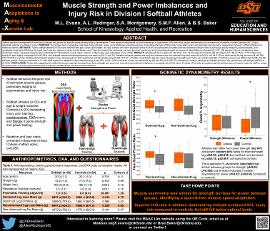| dc.contributor.advisor | Baker, Breanne | |
| dc.contributor.author | Evans, Madison L. | |
| dc.contributor.author | Redinger, Allen | |
| dc.contributor.author | Montgomery, Sloane | |
| dc.contributor.author | Allen, Shawn | |
| dc.date.accessioned | 2023-05-04T15:26:02Z | |
| dc.date.available | 2023-05-04T15:26:02Z | |
| dc.date.issued | 2023-04-18 | |
| dc.identifier | oksd_URS_2023_evans | |
| dc.identifier.citation | Evans, Madison L., Redinger, Allen, Montgomery, Sloane, Allen, Shawn (2023, April 18). Muscle strength and power imbalances and injury risk in Division I softball athletes. Poster session presented at the Oklahoma State University Undergraduate Research Symposium, Stillwater, OK. | |
| dc.identifier.uri | https://hdl.handle.net/11244/337532 | |
| dc.description.abstract | Softball requires development of lower body strength and power but specific demands may lead to asymmetries. These adaptive imbalances such as quadriceps to hamstrings (H:Q) ratio may impact performance and increase risk of anterior cruciate ligament (ACL) injury, potentially altering an athletes’ career. PURPOSE: To compare body composition and lower body strength, power, and imbalances using Dual-energy X-ray Absorptiometry (DXA) body composition scans and isokinetic dynamometry, respectively between softball athletes and matched controls. METHODS: Twenty softball athletes (n=20) were matched with age- (±2yrs) and weight- (±5kg) controls who were physically active ≥3 d/wk. All participants provided voluntary informed consent, filled out physical activity frequency questionnaires, and completed a total body DXA scan to asses total body and regional muscle and fat tissue mass. They then tested their dominant and non-dominant quadriceps and hamstrings strength and power at three different velocities (60, 120, 180 deg/sec). Group comparisons were conducted using a univariate analysis after controlling for individual leg muscle mass, Cohen’s d effect sizes were calculated, and α=0.050. RESULTS: Athletes (20.0±1.7 years old, 163.0±34.1cm, 72.2±7.3kg) and controls (20.2±1.0years old, 166.7±7.5cm, 71.5±7.2kg) were similar for age, height, bodyweight (all p≥0.643), and average resistance training frequency per week (p=0.611; d=0.16). Athletes indicated greater total body and dominant and non-dominant leg lean mass (all p≤0.050; d=0.64-0.75) but were similar for leg fat mass (all p≥0.095; d=0.47-0.53) to controls. Athletes demonstrated greater torque at all speeds for both quadriceps and hamstrings (all p≤0.022; d=0.47-1.32) after correcting for leg lean mass. Quadriceps strength asymmetry was similar (p≥0.992; d=0.00) but power was different (p≤0.038; d=0.65) between groups. Strength and power H:Q ratio were superior in athletes for their dominant leg (all p≤0.050; d=0.61-0.76) but similar in their non-dominant leg (all p≥0.563; d=0.19-0.57) compared to controls although all athletes fell below the optimal ratio percentage of 65% (all ≤51.6%). CONCLUSION: These data suggest sport-related demands superiorly develop lower body strength and power but may elicit asymmetrical imbalances, increasing risk of ACL injury. Findings of this nature provide insight to performance and sports medicine staff on career-impacting injury risk and support assessment of regional, isolated tissue and torque characteristics. | |
| dc.format | application/pdf | |
| dc.language | en_US | |
| dc.publisher | Oklahoma State University | |
| dc.rights | In the Oklahoma State University Library's institutional repository this paper is made available through the open access principles and the terms of agreement/consent between the author(s) and the publisher. The permission policy on the use, reproduction or distribution of the article falls under fair use for educational, scholarship, and research purposes. Contact Digital Resources and Discovery Services at lib-dls@okstate.edu or 405-744-9161 for further information. | |
| dc.title | Muscle strength and power imbalances and injury risk in Division I softball athletes | |
| osu.filename | oksd_URS_2023_evans.pdf | |
| dc.description.department | Kinesiology, Applied Health and Recreation | |
| dc.type.genre | Poster | |
| dc.type.material | Text | |
| dc.type.material | Image | |
| dc.subject.keywords | softball | |
| dc.subject.keywords | muscular strength | |
| dc.subject.keywords | acl injury | |
| dc.subject.keywords | biodex | |
| dc.subject.keywords | dxa | |
